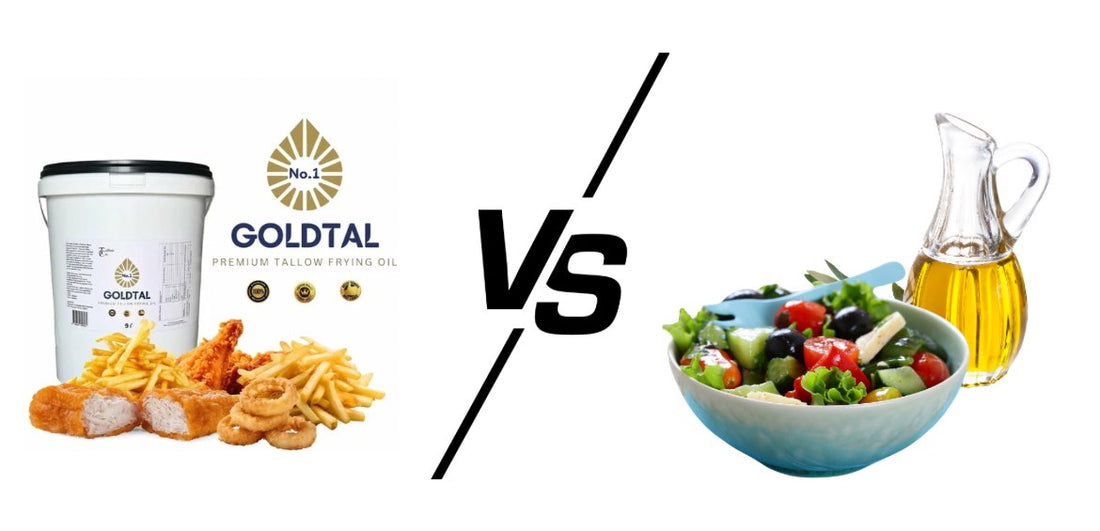
Tallow vs. Olive Oil: A Head-to-Head Comparison
Share
When it comes to cooking fats and skincare ingredients, tallow and olive oil are two heavyweights that often spark curiosity. One’s a rendered animal fat, the other a plant-based staple of Mediterranean cuisine. They seem worlds apart, yet both have passionate fans swearing by their benefits. So, how do they stack up? Let’s break it down—flavor, nutrition, uses, and more—to help you decide which one deserves a spot in your kitchen or bathroom.
What Are They?
Tallow is fat rendered from animals, usually beef or lamb, though pork fat yields lard (a close cousin). It’s made by slowly heating fatty tissue until the pure fat separates from any connective bits. Historically, tallow was a kitchen essential—think frying, soap-making, even candle-crafting. Today, it’s having a comeback, especially among traditional food enthusiasts and DIY skincare buffs.
Olive oil, on the other hand, is pressed from olives, the fruit of the olive tree. It’s been a cornerstone of diets and cultures for thousands of years, especially in places like Greece and Italy. Available in varieties like extra virgin, virgin, or refined, it’s prized for its flavor and health perks.
Flavor and Cooking
If you’re cooking, flavor matters. Tallow brings a rich, savory depth—think of the taste of a perfectly seared steak or crispy fried potatoes. It’s bold and unapologetic, which makes it a star for roasting vegetables or frying. But that meaty undertone? Not everyone’s cup of tea, especially for lighter dishes or baking sweets.
Olive oil is more versatile in the flavor department. Extra virgin olive oil has a fruity, peppery kick—great for drizzling on salads or dipping bread. Refined versions are milder, making them a go-to for sautéing or baking. It won’t overpower delicate flavors, but it doesn’t deliver that intense richness tallow offers.
Heat tolerance is key, too. Tallow’s high smoke point (around 400°F or 205°C) makes it a champ for high-heat cooking like frying or searing. Olive oil varies—extra virgin tops out around 375°F (190°C), while refined versions can handle more heat. For deep frying, tallow might edge out olive oil, but for everyday cooking, both hold their own.
Nutrition Breakdown
Health-conscious? Let’s talk nutrients. Tallow is mostly saturated fat (about 50-55%), with monounsaturated fats (like oleic acid) and a bit of polyunsaturated fat. It’s naturally rich in fat-soluble vitamins like A, D, E, and K, especially if it’s from grass-fed animals. Some claim it’s a “traditional superfood,” arguing our ancestors thrived on animal fats. Critics, though, point to the saturated fat content and its potential link to heart disease—though modern science is still debating that one.
Olive oil is the darling of the health world, thanks to its high monounsaturated fat content (around 73% in extra virgin). It’s loaded with antioxidants like polyphenols, which may reduce inflammation and protect against chronic diseases. Studies, like those behind the Mediterranean diet, often praise olive oil for heart health. It’s lower in saturated fat (about 14%) and has no cholesterol, since it’s plant-based.
Winner here? Depends on your priorities. Olive oil’s got the research edge, but tallow fans argue it’s unfairly demonized and offers unique nutrients.
Beyond the Kitchen: Skincare and More
Surprise—both tallow and olive oil moonlight as beauty products! Tallow is a rising star in natural skincare. Its fatty acid profile mimics human sebum (skin oil), making it a hydrating base for balms and creams. Packed with vitamins, it’s said to nourish dry skin or even calm conditions like eczema. The catch? It’s thick, greasy, and smells faintly beefy unless refined.
Olive oil has been a beauty hack since ancient times. Cleopatra supposedly bathed in it (or so the legends say). It’s lighter than tallow, moisturizing without feeling heavy, and great for hair or as a makeup remover. Its antioxidants might even fight aging. Downside? It can clog pores for some skin types.
For DIYers, tallow’s also a classic for soap-making, while olive oil shines in recipes like castile soap. Both are winners, but tallow’s heft suits hardcore moisturizing, while olive oil keeps it simple and light.
Sustainability and Cost
Tallow can be sustainable if sourced from local, grass-fed livestock—using a byproduct that might otherwise go to waste. But industrial meat production? That’s a carbon footprint headache. Cost-wise, it’s often cheap if you render it yourself, though pre-made tallow can get pricey.
Olive oil’s eco-story depends on where it’s from. Mediterranean groves can be sustainable, but mass production and shipping add up. Price varies wildly—cheap bottles abound, but quality extra virgin can break the bank.
The Verdict
So, tallow or olive oil? It’s not a one-size-fits-all answer. Choose tallow if you love bold flavors, high-heat cooking, or heavy-duty skincare—and don’t mind its animal origins. Go for olive oil if you want versatility, a lighter touch, and a plant-based option backed by health hype.
Me? I’d keep both handy. Tallow for frying up a storm, olive oil for drizzling on everything else. Why pick a side when you can have the best of both worlds?
